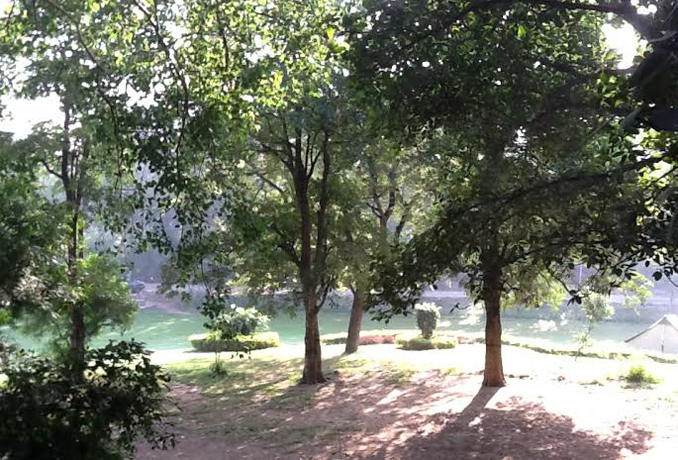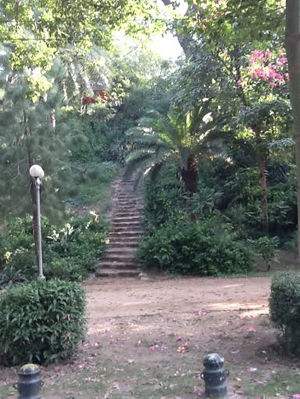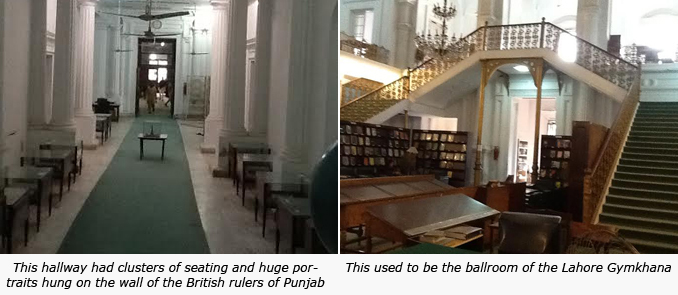Written by: Dr. Dushka H. Saiyid
Posted on: October 20, 2014 | 
John Lawrence
As a little girl who lived right across from the Lawrence Gardens, I remember watching a military brass band marching through the Gardens with a ram mascot accompanying the bandmaster waving his baton. The mascot was covered in red cloth, the same as the rest of the band, with the insignia of the regiment embroidered in gold, marching proudly next to the bandmaster, his thick round antlers giving it a majestic look. The music resounded in the park as people collected to watch this delightful pageant.
Lawrence Gardens were named after the first Chief Commissioner of Punjab, Sir John Lawrence. He played a key role in suppressing the revolt of 1857, and later was appointed Viceroy of India from 1864-69. Lawrence Gardens, renamed Jinnah Park after partition, reflect the imperial vision of those who ruled India.
 |
Magical morning light filtering through the trees |
These regal gardens were built in 1862, not long after the annexation of Punjab to British India in 1849. Consisting of 172 acres, it has now been whittled down to 142 acres, as the Zoological Gardens have been separated from it and some of its land taken away by the construction of roads. According to its dedicated Director, Mr. Shahid Iqbal, Lawrence Gardens were modeled on the Kew Gardens of London, as were the Eden Gardens of Calcutta, and the administrators of the three were interchangeable. Species of plants were collected from different corners of the empire and used to enrich the botanical gardens of these parks.
 |
The hill opposite the Fatima Jinnah Park |
This beautifully landscaped park has two hills, a cricket pavilion and three clubs, now reduced to two, and an Open Air Theatre. But the jewel was the Gymkhana Club; originally Lawrence and Montgomery Halls that were later conjoined in the 1860s, and now house the National Library. It is a grand Victorian structure, somewhat reminiscent of a country mansion in Britain that dominates the landscape of the park. The smaller Cosmopolitan Club is right in the center, with its own lawns and the Ladies Club, also known as the Purdah Club, is at the corner of Lawrence Road and the Race Course Road.
In front of the Gymkhana Club, now the National Library is a large roundabout with fountains in the middle and benches all around it. In the 50s Parsees, most of them old and hunched, used to congregate around the fountains in the evenings, enveloped by a quiet sadness. Parsees were the elite of the Indian society, successful businessmen and professionals, but suddenly the empire had been swept away by the currents of history, and mob violence of partition had vitiated the atmosphere for all minorities. Within a few years, this cultured and sophisticated religio-ethnic group was gone, uncertain about their future in this new homeland for Muslims.
While there was activity in the Cosmopolitan Club, the Ladies Club was a center for the ladies of Lahore; the Open Air Theater held the annual All Pakistan Music Conference, but it was the Gymkhana Club that was the hub of social activity. I used to cycle to the Gymkhana Club to play lawn tennis; its grounds in the Lawrence Gardens would move to new spots every couple of weeks, as those with worn grass were watered by canal water. The Club had an enormous ballroom with wooden floor, and I watched with fascination as couples swirled by at the New Year’s Ball. That elegant room with grand staircases going up to the balcony encircling the ballroom, now looks decrepit and run down, with a dirty carpet covering the floor. It has become the main reading room of the National Library. The empty and deserted hallway had clusters of seating in its alcoves, while man-sized stern looking portraits of the sahibs who had ruled over Punjab stared down. At the end of the hallway was a beautiful room with walls covered in walnut wood, where parties and get-togethers were held. It has now been converted into a musty dimly lit seminar room.
 |
Diminished, but still a place of wonder and magic, as one wanders up its hills and tucked away benches to ponder the glory that the Gardens once were. A majority of its trees, over a hundred years old, whisper their secrets having witnessed so much. The Fatima Jinnah Park is still manicured, although no receptions for visiting dignitaries are held there anymore. The hill opposite is as enticing as ever, with old twisting trees, each one a wonder of nature; the plateau at the top of the hill is crowned by a luxuriant tree with benches around it, an escape for sweethearts or those seeking peace and tranquility. As I climb down on the other side of the hill towards the Zoo, the roar of the lion reverberates in the air despite the noise of the traffic, and the bats are noisy in the trees above, for as the sun rises they are settling down to sleep. My melancholy lifts as I stare at this wondrous creature hanging from the branches of the trees; they are much less in numbers than before, as are the trees they hang from, but they are still there.
Popular walking tracks have been added, as the distasteful faux mini Shalimar Gardens, but there is much to celebrate in the Gardens, a part of our treasured heritage, although I wish they hadn’t removed the statue of Sir John Lawrence, with a pen in one hand and a sword in the other.
Click to view picture gallery
You may also like: